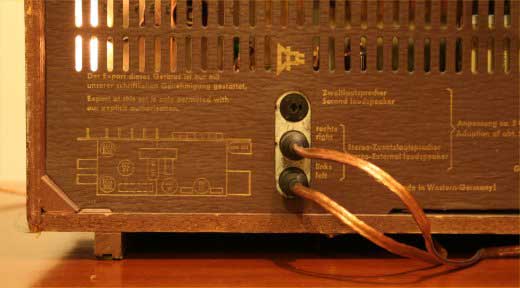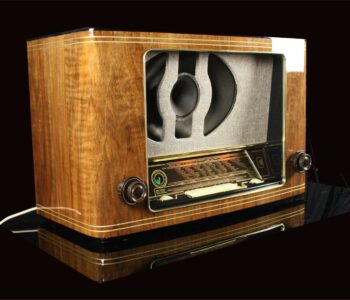 german radios - en
german radios - en
Saba Stereo I SRI-16 – SRI 18 – en
- by giovanni
SABA STEREO I SRI-16 – SRI 18
SABA STEREO I SRI-16 – SRI 18
The translation for Steuergerät is Control Electronic Unity. It encloses the tuner and the speaker, both stereophonic and you can connect a record player as well as a CD/DVD player along with any other kind of acoustic source. What interested me of this device was the great SABA experience on Steuergerat. Before getting to the SRI-16 SABA produces the Freiburg Studio in 1962, the Freiburg Studio A in 1963 and the Stereo Studio 1 in 1964 to finally produce this new and wonderful device in 1965.
SABA quality is really visible and audible.
Its line is different from any other device of that time. a big single serigraphed glass screen with a big stylized indicator of the ferrite curve’s position on the right. Small knobs, all looking the same with different serigraphies according to their function, a single keyboard gathering all functions.
A design that puts functionality first. Elegant and not tiring.
Its musical features deserve a detailed description, which will be given further on.
I coupled this device with a pair of wonderful Celestion 120, the popular boxes built in the Ditton factory. The following boxes will be sold as Celestion Ditton. They represent the utmost expression of English musicality of that time among affordable devices.
These boxes’efficiency is enough to make the SABA sound out loud. Even in this case I tried to couple it with another pair of boxes among my favorites, some 600 Grundig boxes, but the result was not satisfactory. A bass sound excess was immediately noticeable. Acute sounds were precise but the Celestions give a clearer sound image.

-
BLUETOOTH
Bluetooth receiver embed -
MULTI PLATFORM CONNECTION
Each radio is equipped with a cable for connection to any digital device.
TUBESOUND IMPROVEMENT
- Bluetooth receiver embed – The unit is equipped with a BLUETOOTH receiver powered directly by the receiver power supply. This makes it possible to control the amplifier from any external digital device as an IPAD, a Smartphone, or a sophisticated multimedia station. So you can hear your preferred web station or your lossesless file without cables on the room. Wireless Receiver can be equipped upon requests.
– Multi Platform Connection – A customized adaptation cable to connect any digital device as Iphone, Smartphone, Laptop, CD Player etc. will be provided with this radio. This special cable suits the different impedances between the modern equipment and the receiver. Furthermore the two stereo channels flow into one without increasing the load to the input unit.


HISTORY
SABA is the acronym for Schawarzwälder-Apparate-Bau-Anstalt meaning engineering institute of Technological appliances of the Black Forest.
The company was founded back in 1835 by Joseph Benedikt with the initial name of Jockele-Uhren, but only in 1923 the production of radio devices began and the company went under the name of SABA.
Toward the end of the 20s SABA became famous with the well-known S35 and in the following years it became the second German producer after Telefunken. During the war SABA produced military equipment and in 1945 the company was completely destroyed by a bombing.
In 1947 the production of radio devices began again and SABA distinguished itself immediately for ist avant-garde and high- quality production.
hey also began to produce TVs (the first PAL color TV is a SABA), house appliances and medical equipment. Many Italians used to work there. The Alnico Greencone loudspeakers became popular for their linearity, power handling, constant impendence that would be employed in each Hi-Fi devices of that time.
The radio devices with motorized tuning became popular as well and SABA became the representative German brand meaning quality, reliability and detailed precision. In the 1970s the decline began. According to specialized magazines of that time not having a Japanese device at that time meant not having Hi-Fi. In the 80s Thompson took over SABA. In the 90s the other way around, having a Japanese device of the 70s meant not having Hi-Fi. They found out that they functioned with a 96% counterreaction and that a device with 0.001 db from 1 to 100 KHz extension did not necessarily sound good.
We do not trust our ears and we do trust what other people say not necessarily with a good purpose.
2007: due to insolvency SABA disappeared from the TLC (Chinese) and Thompson (French) joint venture, and SABA ceased to exist.
MAIN FEATURES
Year of production: 1965
Superheterodyne IF: 460/10700
6 AM Circuits
11 FM Circuits
Wavebands: Medium Waves (OM), Long Waves (OL), Short waves (OC), FM (UKW)
Operating voltage (CA):
110; 125; 160; 220 Volts
External loudspeakers
Dimensions (LHD):: 645 x 235 x 220 mm; 25.39 x 9.25 x 8.66 in
Net weight: 15 kg; 529 oz
7 Tubes: ECC85 ECH81 EAF801 ECC83 EMM803 ECLL800 ECLL800
Rotating ferrite antenna for MW


EXTERNAL LOUDSPEAKERS
This device is not equipped with speakers placed inside the cabinet as any modern tuner-amplifier
STEREO MPX DECODER
The radio is equipped with a tube Stereo-Decoder, that means it is a real stereo, not like most other vintage radio that used to be mono in the radio FM and stereo sections only because of the double final section. To be clear, the record player could be played in stereo, but the radio only in mono.


AERIALS
Inside the cabinet there is a dipole for FM reception and a ferrite rotating aerial for AM reception.
Ferrite aerial can be rotated from the outside to achieve a perfect tuning of the device in the AM.
In this picture see the rotation mechanism and the position indicator of the aerial.
The reception sensitivity with internal aerials is very good. This unit was in fact produced in a period when there were not many radio stations and those available fairly apart from each others.
Using an external aerial sensitivity is further increased.
SEPARATE CONTROL TUNING BETWEEN AM AND FM
The FM section is built with a very reliable ECC85 amplifier / mixer-oscillator.
The FM and the MW sections are controlled by separate knobs.
The mechanical complexity of this solution is minimal, greatly increasing the reliability of the system.


TUNING INDICATOR
The magic eye has of course been replaced.
At the top on the left we find the magic eye divided in two sections, the first indicated whether the station is in stereo, the second indicates the perfect tuning of each station. Next to it we find the Short, Medium and Long Wave AM bands scale.
The lower scale is the FM bands scale.
The buttons starting from the left:
On/Off- Long Wave – Medium Wave – Short Wave – FM – Phono – Mono/Stereo
The first knob on the left is the acute sounds control. Then the bass sounds control and the volume control (with incorporated loudness) knob.
On the same axis we find the knob of the balancing between the right and left channel.
There are then two separate knobs for the tuning control in the AM and FM bands. On the same axis of the tuning knob there is the rotating switch inserting the AFC (frequency automatic control- preventing the tuning slipping once the station is centered)
Note that on the tuning knobs there is a point of the same color of the index where the knob operates.
The last knob on the right is the one that allows the rotation of the ferrite curve for the AM bands. Above this one we find a big stylized indicator of the curve’s position with the automatic switch in the zero position.
LISTENING IMPRESSIONS
Important disclaimer: I am not an expert audiophile and my impressions have the value of mere personal impressions.
The radio section is perfect, stable and with a perfect selectivity still today and with an easy tuning thanks to a long scale.
Other competitor devices (as far as the Graetz Stereo Unit 250 or the Grundig Stereomeister 3000 are concerned) had 5/6 pre-selectable and memorizable stations, but on this one, the Stereomeister, this gem became the source of many problems.
My testbeds have been Hosianna Mantra, the masterpiece of Popol Vuh and The 6 Unaccompanied Cello Suites by Bach played, or better, interpreted by Yo-Yo Ma.The CD player is a Grundig CD35, the best machine I ever had the pleasure to work with. Even on this device the roundness, the smoothness and the richness of bass sounds and the never worn out high sounds are its main features.
The listening struggle with the couple Saba/Celestion never comes.
Compared to other machines using the same counterphase you have the feeling to have more power, but this is only a feeling: power is around 9 W RMS per channel. Too loud and efficient loudspeakers could modify the features of the final stage.
I am trying to figure out whether I should include Allevilive by Giovanni Allevi among the reference CDs that I use to test the devices.
With the Saba/Celestion couple Allevi’s piano is always very lively and rich of harmonicas. It requires the volume to be high, the piano is a very difficult instrument to reproduce. I do not have the listening reference with other devices.
THE USUAL AMAZING LAST IMAGE























